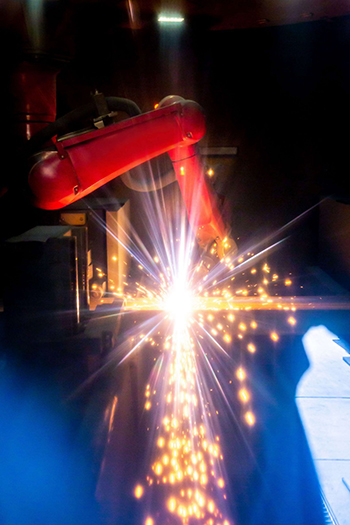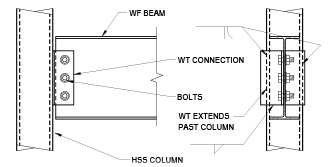Insights from a Steel Fabricator: Overcoming Fabrication Challenges through Communication, Technology, and Experience
Fabricator’s Perspective: Jesse Bessmer, Director of Project Management and Quality Assurance at Metal Works.
Our team was able to meet with Jesse Bessmer, director of project management and quality assurance at Metal Works, to discuss his opinions on overcoming HSS challenges from a fabricator’s perspective.
Q: Can you tell us about your background and current role?

A: I started with Metal Works in 1997 while I was still in high school. After high school, I served four years in the Navy, then returned to Metal Works where I worked in many departments, including structural steel fabrication as a welder, a fitter, quality control and shop manager, and I eventually advanced to the position of director of project management and quality assurance.
In 2021, I passed a test to become a certified welding inspector (CWI), and recently I passed a contractor state license exam C-60 for welding.
Q: Could you describe Metal Works and the type of steel structures you typically fabricate?
A: Metal Works is a structural steel fabricator located in Oroville, California. We are a full-service fabricator from detailing to erection and have an 18-acre campus with four fabrication facilities. We typically fabricate commercial, industrial, educational and health care in both public works and private projects.
Q: Do you have any notable HSS project(s) you have worked on?
A: This is a personal one, but we had a project back in 2007 or 2008. It was a high school that had a tube steel frame that the school’s logo was going to be mounted to. I was assigned to fabricate every piece out of round HSS. Each piece had to be custom beveled or coped on each end. Each HSS member was rolled to a specific arc dimension, and it really stands out to me as a memorable project.
Q: Based on your past experience, what is key to a successfully fabricated steel project?
A: The big thing is communication. We have made a lot of changes in our organization as far as how we communicate with the general contractors and the detailers. BIM modeling and Microsoft Teams are both beneficial to us for our communication.
Q: Could you tell us about any special equipment, tools or processes Metal Works uses to allow for more efficient HSS fabrication?

A: Metal Works made large investments in automated machinery in the last couple of years, and it has taken the torch out of the hands of the shop employees and has increased our quality as well. We invested in robotic plasma cutter technology that has really helped the shop employees out.
Q: It is important for design and construction teams to collaborate and understand each other’s challenges. Is there anything you wish engineers knew about fabricating HSS that would help you on the fabrication side?
A: When designing trusses and canopies, have the web members designed smaller (or narrower) to eliminate the flare bevel welds. If you have a smaller piece tying in, you’re not going to have that flare bevel on top and bottom, and it helps eliminate much of the distortion during the welding process.
We also experience a lot of projects with CJP splices on columns with materials from different mills. Typically, the corner radiuses are different from two different mills, so they don’t match up and it takes a long time to fit the backing bars. You can’t just cut a straight backing bar with the same radius. We must grind one side more than the other side to get it to fit in perfectly. Every one of the backing bars will have to be made custom to meet the requirements of AWS D1.1 regarding the gap between the inner wall face and your backing bar. It’s a lot of extra time in the shop when CJP splices are specified. Every mill is different, so maybe some standardization among the mills needs to take place in this regard.
For column splice connection alternatives to CJP splices, refer to the resource references at the end of this article.
Q: Could you describe specific HSS details that quickly increase fabrication costs (i.e., CJP welds, etc.)? Conversely, could you describe specific HSS details that help decrease fabrication cost?
A: CJPs definitely increase the fabrication costs along with flare bevel welds. If the design team doesn’t specify the effective size of the flare bevel, it requires a fabricator to fill the joint flush. The best weld designs that decrease cost when fabricating HSS are the ones that use square or rectangular tubes and only require a fillet weld.
Q: What is your preferred standard shear connection for wide flange beams to HSS and why? Preferred moment connection?

A: We prefer to have the shear connections welded to the face of the HSS and not slotted through the HSS. This eliminates splicing the HSS at each floor. If a standard shear connection cannot meet the kips that are required for that location, then we request to use a WT for the connection so we can just mount that to the side of the column instead of having a slot through.
For moment connections, Mr. Bessmer described that through plate moment connections, where the top and bottom flange plates extend horizontally through the HSS, are challenging to fabricate. This is particularly true of three- and four-sided moment connections. It is much more labor-intensive in the shop because the column is typically cut and spliced at the connection, as Mr. Bessmer describes further below.
If it’s a three- or a four-way connection at that spot, we’re going to have to cut the column at that location. But there’s no way for the fabricator to connect those connection clips at that location until they slot the tube. They slide the connections in because the connections have to be welded on the inside, and then cap it and splice that onto the other top section at the next floor and just keep going. [For two-sided moment connections], a single knife through with a shear tab or a WT on the opposing side is what we prefer because we don’t have to cut that column to get a three-way or a four-way splice in there.
For moment connection alternatives to through-plate moment connections, refer to the resource references at the end of this article.
Q: Do you see challenges with slotting plates into HSS members? If so, do you have detailing tips to share to ease this process?
A: We only have issues with slotting round HSS due to the alignment of the two ends, like on tubes in braced frames. If they’re out of alignment, then the erector is going to put one side on and he is going to have an issue with the alignment of the other side.
Q: Have you seen projects where the HSS member specified in bid drawings was found to be inadequate during the connection design phase and the HSS needed to be upsized or reinforced? How would you suggest things be done differently to help with this challenge?
A: Rolled HSS wall thicknesses is what we run into issues with. If the wall thickness is too small, it will buckle or have a wave in the material. When 3/16-inch wall thickness is specified, the places we send out to for the rolling will request going to 1/4-inch or heavier wall thickness. This is so they don’t end up with a wave effect or buckle after they’re processed.
Q: You said that your favorite machines include automated equipment and software. How do you see robotics impacting the fabrication industry in the future?
A: Technology and automation are enhancing the steel fabrication industry. We see more and more that manual shop labor will be replaced with automation, helping safety and quality ultimately improve, too.
Q: Do you have any last thoughts you’d like to share regarding HSS or overall steel fabrication?
A: Better communication with the design teams and the fabricators. With the fabricators not being involved at the beginning stages of a project, it makes it tough and creates a lot of fabrication issues and unnecessary cost in the project.
Stop specifying material that is nonstandard because it typically requires waiting for a mill run of that size. Instead of just going to the AISC book and picking out a size, pick something that’s more common and try to design around that.
Design columns that are not the same size as the finished walls to eliminate clearance issues. A lot of times, you’ll have a 6-inch wall and they’ll classify a 6-inch HSS going in that wall where you have no tolerance at that point. If they went to say a 5-inch column and a 6-inch wall, that’ll give a little clearance.
Design connections with PJPs in lieu of CJPs to save costs on fabrication and inspection. Inspection costs are going up, and this will help reduce the amount of inspection required.
Extend the shear connection plate holes past the beam flange to eliminate the need for copes on beams. This takes a lot of the time out of the fabrication process.
And one of the biggest issues fabricators face are the roof openings for the mechanical equipment. It would be nice to see the design teams use BIM modeling to speed up the review time and allow the fabricator to process all the steel at one time. Many times, the mechanical sub is not on-site or has not submitted any drawings when the steel is being submitted. The roof usually has a lot of steel because of the openings. It’s a huge holdup for the fabricator waiting on the mechanical sub to submit their drawings and coordinate their openings. It would be nice if they can bring the mechanical sub on earlier.
Resources for WF Beam to HSS Column Moment Connections
For a summary of moment connections to use in lieu of through-plate moment connections, see the STI resources below:
Wide-Flange Beam to HSS Column Moment Connections
Webinar On Demand: HSS Moment Connections
HSS DESIGN MANUAL, VOLUME 3: CONNECTIONS AT HSS MEMBERS
Includes design examples for various HSS moment connections
HSS Producers Capability Tool
Use the STI’s HSS Capability Tool to determine which HSS sizes are regularly produced.
Expert Tips for Cost-Effective HSS Specification and Fabrication
HSS are an increasingly popular choice in structural steel design. They offer superior strength-to-weight ratios, and their smooth and uniform appearance make them an attractive option for architectural applications. However, when appropriate considerations are not taken, fabrication can be challenging and expensive. We interviewed 11 fabricators for tips on specifying HSS to be more cost effective and efficient.